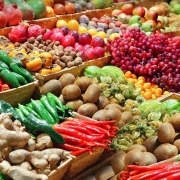6 Must-Have ERP Features for Food & Beverage Companies
These days, businesses in the food and beverage industry face tough choices when selecting new software systems. Many food industry-specific systems are outdated and lack features found in modern systems like mobile capabilities, online ordering, and out-of-the-box integrations. But general-purpose manufacturing or distribution ERPs often lack critical functions for the food industry.
When selecting a new ERP solution, consider these key features to ensure you have the best of both worlds: industry-specific must-haves with the latest in modern ERP technology.
- End-to-end lot traceability – from purchase to sale.
Collecting full traceability data can be a headache, and old-school business software often makes it difficult. But if you’re able to easily collect data, you can trace ingredients from your purchase order, through manufacturing or warehouse transfers, all the way to sale to your customer.
Similarly, you can easily follow up with complaints by tracing a shipment all the way back to the ingredients that went into it.
One-click traceability is absolutely crucial in the event of a recall. Rather than issuing a public blanket recall, you can easily pinpoint compromised goods to be scrapped/quarantined, identify any goods that were sold, and limit the scope of the recall as much as possible.
Maintaining your chain of traceability is critical to the health and safety of your customers and the reputation of your company, and modern ERP solutions make the task as easy as possible with seamless lot barcoding/labeling, raw materials capture, and finished goods capture at the time of sale/shipment.
- Expiration date management.
Expiration date management functionality allows you to capture the expiration dates of raw materials and finished goods – whether they’re recorded at the time of receipt/production, or automatically (standardized expiration windows for inbound fresh product or finished goods).
Easy reporting is available detailing items that are expiring soon, providing opportunities for them to be sold on clearance or donated before they expire. Scrapping expired material is as easy as a click of the mouse, and modern systems ensure that expired materials cannot be sold or used in production.
- Flexible units of measure and catch weight capabilities.
Robust support for convertible units of measure is critical in the food industry. Most food operations have ingredients that are used in multiple units of measure – for instance, purchased by the bag, stocked by the ounce, and used in production by the gram. Complex, item-level conversions are often necessary to handle nonstandard conversions like gallons to pounds.
Ensure that any ERP system you choose is flexible enough to support many units of measure at a system and item level, and to allow flexibility in how they are used. (For example, one raw material should be able to be used on different recipes/formulations with different UOMs referenced.)
In many industries – meat, seafood, and produce in particular – catch weight tracking can also be very important. Catch weight items are sold in a nominal unit of measure at a nominal price (for example, one case for $50) but sold based on the quantity/volume of goods actually shipped to the customer (for example, 10LB at $5/lb).
- Mobile-friendly capabilities.
To stay competitive, it’s no longer sufficient to rely on only having access to data when you’re sitting at your desk. Modern, cloud-based ERP solutions give you full access to system features and functionality – including real-time reporting – from any location.
As your team performs their daily duties – from your warehouse staff loading pallets onto trucks to your sales team on the road taking orders from customers – data is pushed to the system in real-time from their tablets, handheld computers, or cell phones.
Mobile capabilities have been particularly helpful to our customers during the COVID-19 pandemic, during which many companies needed to move a large portion of their workforce to work-from-home to ensure the safety of their personnel. Mobile access means that even when working from home, your team has all the access to do their jobs, quickly and reliably, with no need for slow VPNs or clunky client software.
- Process manufacturing with seamless batch management.
Most general-purpose manufacturing systems are not a good fit for food and beverage companies because they tend to be built around discrete manufacturing processes. Discrete manufacturing assumes that you are producing a specific quantity of a given product following a fairly rigid specification.
For example, manufacturing bicycles is a great example of discrete manufacturing. If you are building bikes, you will never make half a bike or 7.25 bikes. You also are unlikely to build a bike with 1 wheel or 8 wheels, or to put a 2×4 plank in the place of the handlebars.
But food and beverage is a different world. Production is based on an expected yield, but your yield may be more or less than expected. Similarly, you may produce items in batches (for example, 1,000 cookies, but made in 10 batches of 100). You may choose to substitute ingredients or make slight adjustments to the formulation as needed.
Manufacturing software with process manufacturing workflows allow you to handle these complex use cases within the manufacturing system, allowing full capture of actual vs. expected yield, substitutions, and multiple lots/batches produced as a result of a single work order.
- Efficient and simple online ordering.
In the age of Amazon, customers expect online ordering to be a simple and straightforward process. B2B (business-to-business) portals allow customers to log in to a private e-commerce site any time they’d like to place orders, check pricing and stock availability, track deliveries, and even pay invoices.
Portals provide a wide variety of advantages – from up-sell/cross-sell to accelerated cashflow – but the biggest selling point is the simplest: customers get the advantage of fast and easy, 24/7 self-service, and you reduce load on your customer service team.

